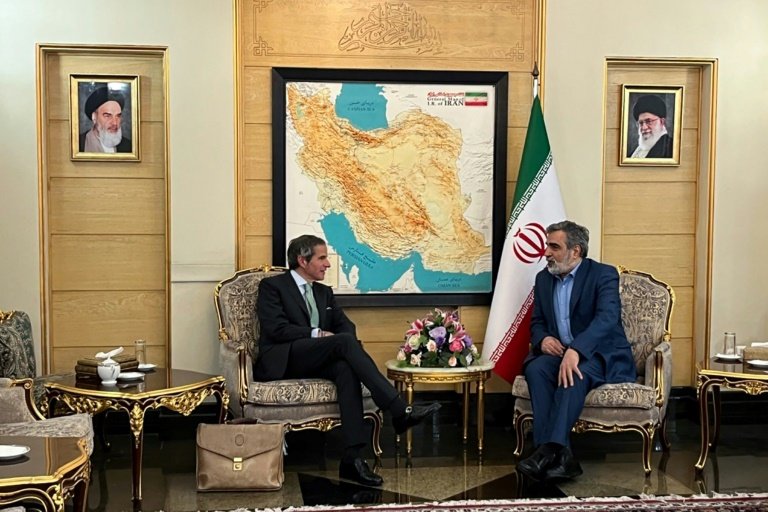By Sébastien RICCI, Ramin KHANIZADEH
- Order Reprints
- Print Article

UN nuclear chief Rafael Grossi (L) speaks with Atomic Energy Organization of Iran spokesman Behrouz Kamalvandi ahead of their tour of sensitive Iranian uranium enrichment plants
–
Text size
The UN nuclear chief toured two Iranian uranium enrichment plants that have been the focus of Western concern on Friday after Tehran said it was ready to address “doubts” about its ambitions.
The visit to Iran by International Atomic Energy Agency director general Rafael Grossi comes after he warned “the margins for manoeuvre are beginning to shrink” over its nuclear programme.
On Friday, Grossi visited the Natanz and Fordo enrichment plants in central Iran, the official IRNA news agency reported.
He was accompanied by Iran’s atomic energy organisation spokesman Behrouz Kamalvandi, photographs posted by IRNA showed.
Expectations have run high that US President-elect Donald Trump will take a harder line with Tehran when he takes office in January, although the New York Times reported Thursday that his tech billionaire ally Elon Musk had met Iran’s ambassador to the United Nations in a bid to defuse tensions.
Neither the Trump transition team nor Iran’s mission to the United Nations immediately confirmed the encounter with ambassador Saeed Iravani. The Iranian mission said it had no comment.
During his first term in the White House, Trump unilaterally abandoned a landmark 2015 nuclear deal between Tehran and major powers and reimposed blistering economic sanctions in a policy of “maximum pressure”.
Tehran eventually responded by rolling back its own commitments under the deal, which barred it from enriching uranium to above 3.65 percent.
The IAEA says Iran has significantly expanded its stocks of uranium enriched to 60 percent, a level that has triggered international alarm as it is much closer to the 90 percent level needed for a nuclear warhead.
Iran is the only non-nuclear-weapon state to enrich uranium to 60 percent, the UN agency has said.
Samuel Hickey of the Washington-based Center for Arms Control and Non-Proliferation, said Grossi’s tour of the two plants was “significant for both technical monitoring and symbolic reasons”.
“Natanz serves as Iran’s main uranium enrichment facility, while Fordo houses some of its most advanced centrifuges,” Hickey said.
Fordo “is among Iran’s most proliferation-sensitive sites,” he added.
Hickey said that by allowing Grossi to visit the plants Iran “is signalling that the easiest access to these facilities is through diplomatic engagement.”
Grossi’s visit comes ahead of a meeting of the IAEA’s board of governors later this month at which Britain, France and Germany could propose a new resolution critical of Iran.
In talks with the IAEA chief in Tehran on Thursday, President Masoud Pezeshkian said Iran was ready to resolve any “doubts and ambiguities” about its nuclear ambitions.
But in his meeting with Grossi, Iran’s nuclear chief Mohammad Eslami threatened instant “countermeasures” if the board adopts an “interventionist resolution”.
“Iran wants to both act like it will cooperate so as to undermine support for a harsh board resolution,” while also threatening retaliation if the board passes one, Institute for Science and International Security head David Albright told AFP.
The outgoing administration of President Joe Biden expressed scepticism about the show of cooperation by Tehran.
“Ultimately, what we want to see from Iran is actual behavioural change and action, not just signs of something or indications of something,” State Department spokesman Vedant Patel said.
